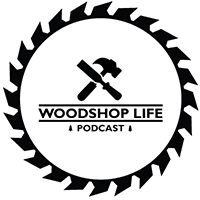Support us on Patreon: https://www.patreon.com/woodshoplife
Guy
1) Hey guys! I know you all have CNC’s in your shop. I am about to buy one and I have about $2500 to purchase one. I have thought about the shapeoko XXL or the shaper origin. I know you have experience with gantry style CNC machines, but what do you think of the shaper origin? Would any of you trade your gantry style CNC machines in for the shaper origin if you had the chance? Isaac
2)Hi fellas — I’m a novice woodworker with a question about the use of dowel versus domino joinery:
I’m trying to understand all the hate and derision that is thrown towards dowel joinery versus all the love and infatuation with domino joinery. It seems to me they are both loose tenon joinery and the only real difference is the shape of the loose tenon. So what makes the dowel such a “poor man’s” joint and the domino an heirloom quality joint? If I use dowels with the same approximate surface area as a domino, won’t I get the same strength and holding power? Is there something special about the rectangular shape of the domino versus the round shape of the dowel?
Thank you! I love the podcast!
David
PS: my daughter wants to be a rocket propulsion engineer, so Huy, you rock! (Guy and Sean are pretty good, too)
Sean
1) Hello Master Woodworkers, I appreciate all you do on the podcast and can’t wait to listen to the next episode. I am getting ready make a bunch of small to medium size boxes as gifts for family out of walnut and maple. I don’t have a spray setup and don’t really have time to learn it this year. I am looking for a fast and reliable finish for the boxes, in a matte to semi-gloss. These will be 3×5 on the small side and 8 x 10 on the large. Thanks for all you do, and keep the podcast coming! – John
2) How to understand the grain and what to look for would be a great topic of conversation for the podcast for beginners like myself. Geoff
Huy
1) Outside of my shop I would like to build a small shed for storing sheet goods. I live in northern Iowa where it can get pretty cold in the winter. is there any potential problems with storing sheet goods outside covered, dry and then bringing them in prior to using them letting the temperature come up to my shop temperature. Would the low humidity cause any harm to structure of the sheets. Marlan Mincks
2) Great podcast, guys! I appreciate all the advice you give. I am a fairly new woodworker and I’ve been building some furniture to start to sell. Nothing massive, trying to stick to smaller pieces because of experience and size of shop. I planned to find people in my area around Nashville TN who appreciate local handmade pieces, but my wife brought the question of what I do if a customer wanted me to ship them the finished product. So my question to you guys is how do I go about figuring that process out? And is it even worth it? I assume I would pass that shipping cost on to the customer. Would be getting into the custom crate building business then too? Thanks for your time! Matthew
